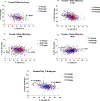Molecular and organismal changes in offspring of male mice treated with chemical stressors
- PMID: 22674528
- PMCID: PMC12379820
- DOI: 10.1002/em.21701
Molecular and organismal changes in offspring of male mice treated with chemical stressors
Abstract
Both gene methylation changes and genetic instability have been noted in offspring of male rodents exposed to radiation or chemicals, but few specific gene targets have been established. Previously, we identified the gene for ribosomal RNA, rDNA, as showing methylation change in sperm of mice treated with the preconceptional carcinogen, chromium(III) chloride. rDNA is a critical cell growth regulator. Here, we investigated the effects of paternal treatments on rDNA in offspring tissue. A total of 93 litters and 758 offspring were obtained, permitting rigorous mixed-effects models statistical analysis of the results. We show that the offspring of male mice treated with Cr(III) presented increased methylation in a promoter sequence of the rDNA gene, specifically in lung. Furthermore polymorphic variants of the multi-copy rDNA genes displayed altered frequencies indicative of structural changes, as a function of both tissue type and paternal treatments. Organismal effects also occurred: some groups of offspring of male mice treated with either Cr(III) or its vehicle, acidic saline, compared with those of untreated mice, had altered average body and liver weights and levels of serum glucose and leptin. Males treated directly with Cr(III) or acidic saline presented serum hormone changes consistent with a stress response. These results establish for the first time epigenetic and genetic instability effects in a gene of central physiological importance, in offspring of male mice exposed preconceptionally to chemicals, possibly related to a stress response in these males.
Copyright © 2012 Wiley Periodicals, Inc.
Figures







References
-
- Aghajanyan S, Kuzmina N, Sipyagyna A, Baleva L, Suskov I. 2011. Analysis of genomic instability in the offspring of fathers exposed to low doses of ionizing radiation. Environ Mol Mutagen 52:538–546. - PubMed
-
- Aguilar-Maheca A, Hales BF, Robaire B. 2001. Expression of stress response genes in germ cells during spermatogenesis. Biol Reprod 65:119–127. - PubMed
-
- Anderson LM, Kasprzak KS, Rice JM. 1994. Preconception exposure of male and neoplasia in their progeny: effects of metals and consideration of mechanisms. In: Mattison DR, Olshan AF, editors. Male-Mediated Developmental Toxicity. New York:Plenum, p. 129–140.
-
- Anderson LM, Riffle L, Wilson R, Travlos GS, Lubomirski MS, Alvord WG. 2006. Preconceptional fasting of fathers alters serum glucose in offspring of mice. Nutrition 22:327–331. - PubMed
Publication types
MeSH terms
Substances
Grants and funding
LinkOut - more resources
Full Text Sources

